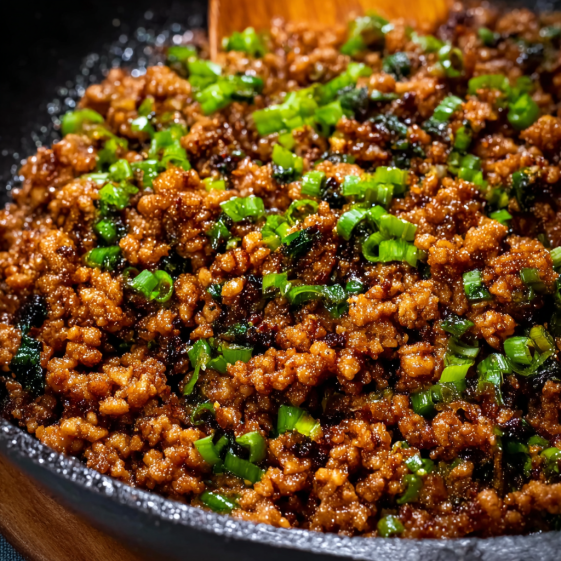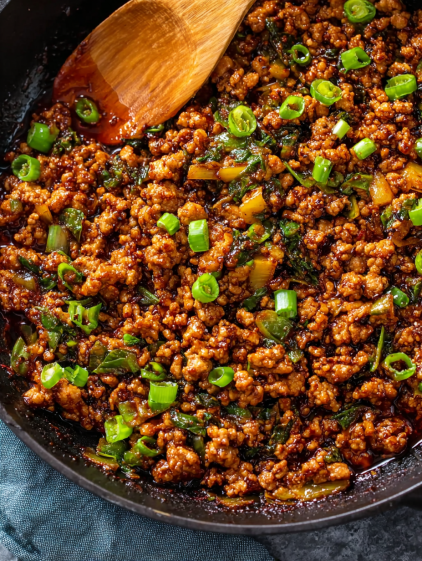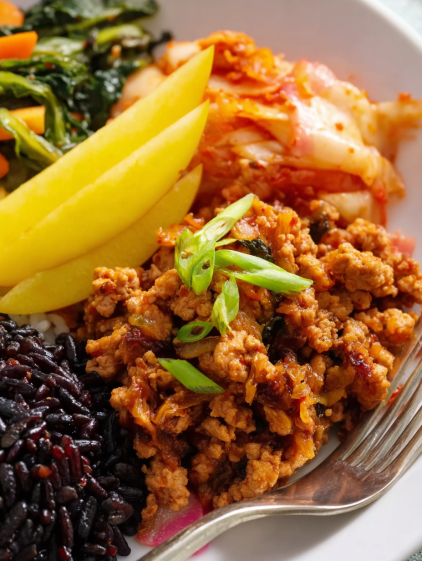 Bookmark
Bookmark
This Korean ground pork is my go to when I am craving something bold and comforting but need dinner on the table fast. The rich blend of savory gochujang paste with garlic and ginger turns humble ground pork into a meal that feels exciting with just a handful of ingredients. It is one of those dishes I reach for when I want to use up leftover vegetables or add a little spark to my weeknight routine.
I first made this on a busy weeknight after hunting down gochujang at my local market. Now when I make it my family gathers in the kitchen with bowls ready to customize their own toppings.
Ingredients
- Ground pork: adds juicy flavor and a rich texture. Choose pork with a moderate fat content for best results
- Gochujang paste: brings that unmistakable Korean heat and fermented umami. Look for bright red paste with a deep aroma at Asian grocers
- Soy sauce: for salty depth. Use naturally brewed or low sodium if you prefer
- Fresh ginger: boosts freshness and heat. Choose pieces with smooth skin and spicy aroma
- Minced garlic: adds sharpness. Look for plump heads with tight cloves
- Spring onions: lift the flavor with brightness and color. Pick bunches with crisp stalks and fresh greens
- Toasted sesame oil: supplies a nutty finish. Always use toasted for that signature scent
- Sesame seeds: for a gentle crunch. White or black seeds both work well
- Rice wine vinegar: offers tang for balance. Opt for clear vinegar labeled specifically for sushi or Asian cuisines
- Brown sugar: softens the heat and rounds out the sauce. Light brown sugar is best but dark works too
Step-by-Step Instructions
- Prep the Vegetables:
- Clean and slice spring onions keeping whites and greens separate. Mince garlic and ginger very fine so they melt into the sauce
- Sauté the Aromatics:
- Warm a large skillet over medium heat. Drizzle in a little oil and add just the white parts of the spring onions plus all the ginger and garlic. Let them cook gently for about three minutes until the kitchen smells fragrant and the bits turn pale golden
- Brown the Pork:
- Crumble in the ground pork using a spoon to break up large clumps. Cook for about eight minutes or until the pork is no longer pink and begins to pick up golden color. Stir frequently and keep the heat at medium so the meat sizzles but does not dry out
- Mix the Sauce:
- Use a small bowl to blend gochujang paste soy sauce rice wine vinegar brown sugar and sesame oil until the paste is smoothed out and sugar dissolved
- Simmer the Pork with Sauce:
- Pour the sauce directly into the pan over the browned pork. Stir well to coat every piece. Turn the heat lower and let everything bubble together for four to five minutes until the sauce thickens and clings to the meat
- Finish and Garnish:
- Take the skillet off the heat. Sprinkle over the green parts of the spring onions and the sesame seeds. If you like extra spice add more gochujang or serve with a pinch of chili flakes

I love how the spring onions brighten this dish. My kids pile them on extra for crunch and joke about who gets the last spoonful of those sweet tangy green tops
Storage Tips
Keep any leftovers in an airtight container in the fridge for up to three days. When reheating splash in a little water or more soy sauce to loosen the sauce and keep the pork juicy. This recipe also freezes well for up to a month if you want to get ahead on meal prep
Ingredient Substitutions
Not a fan of pork? Swap in ground chicken turkey or even finely chopped mushrooms for a meat free twist. If you cannot find gochujang combine tomato paste and sriracha as a backup. Tamari or coconut aminos work instead of soy sauce for gluten sensitivities
Serving Suggestions
Spoon the pork over fluffy jasmine rice or sticky white rice for a classic Korean bowl. Stack up crunchy carrot sticks pickled daikon and nori seaweed for a true street food vibe. Kimchi or sautéed garlic napa cabbage on the side will add tang and even more color

Cultural Context
Gochujang is a classic Korean staple made from fermented soybeans and chili powder. It gives everyday dishes a deep umami character and spice. Using it with pork is a nod to popular home style dishes served with rice and banchan small side dishes meant for sharing
Common Recipe Questions
- → What is gochujang and why is it essential?
Gochujang is a fermented red chili paste from Korea, combining spicy, savory, and slightly sweet flavors. It adds rich umami and deep heat to the pork, which is integral to this dish's signature taste.
- → What can I use if I can't find gochujang?
If gochujang is unavailable, try mixing equal parts tomato paste and sriracha for a similar heat and tangy complexity.
- → Can I use different meats?
Yes, ground chicken, turkey, or beef work well. Adjust seasoning to balance their flavors. Avoid lamb, as it can overpower the dish.
- → What sides go well with Korean ground pork?
Steamed jasmine rice, pickled daikon, shredded carrots, spicy napa cabbage, kimchi, and crumbled nori all make great companions.
- → How can I achieve fluffy jasmine rice?
Rinse rice, add two parts water, bring to a boil, then cover and rest off the heat for 10 minutes. Fluff before serving.
